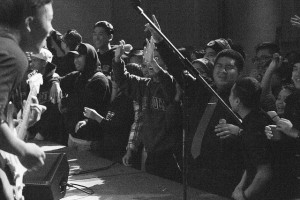
Cal Poly Pomona students enjoy the Barkada talent show at Cal Poly Pomona. PHOTO BY WARJAY NAIGAN/BARKADA
POMONA, California – Blending culture, talent and philanthropy, Filipino-American students at California State Polytechnic University of Pomona (Cal Poly Pomona) held their annual talent exposition at the Bronco Student Center on January 8.
“Barkada Got Talent” (BGT) showcased Filipino American students’ excellence in visual performances including dances and songs at the event sponsored and coordinated by the school’s Filipino club, Barkada, a Tagalog term referring to a group of friends hanging out together.
More than an entertainment event, BGT promotes student networking, mentoring and activism on campus. It is also sending part of this year’s the proceeds to victims of Typhoon Haiyan.
Club president, Jherray Babida told INQUIRER.net that BGT not only brings out students’ talents and abilities, but also demonstrates how they can work cohesively beyond academics.
“Every Barkada event is basically a chance for the board and general members to have some fun while recognizing that culture is one of the biggest aspects of our goals.
The group’s by-laws state: “We as family, friends, students, and people believe that we can only go so far without knowing our culture, but it will always play a big role in our lives.”
Bryan Nagult, the Barkada entertainment coordinator spearheaded the efforts in organizing the show. He underlined how the show’s response to the needs of the Philippines. “And I’m happy to say that I think those goals were very well met,” he said
Nagult said, “Some of the preparations included arranging all the acts, running through the performances with the tech crew, catering the event, setting up a committee to take pictures and record the performances, and meeting with the rest of Barkada’s Executive Board to plan the whole event. Being in charge of all of that really made me feel like I was doing something for more than just myself.”
Barkada’s Board Secretary Jocelyn San Luis said she was surprised at the talents of the members.
“There are some people that you see out there like, ‘Oh my God, I had no idea they could sing or dance like that.’ It’s really cool, and it gives the performers an opportunity to show their skills to a big audience.”
San Luis felt the night’s event was an astounding success. “The audience had a chance to see what kind of work and dedication goes into cultivating great performances.”
Nagult noted the relaxed and recreational atmosphere while celebrating Filipino culture. “The most important part of BGT is to have fun! After all, it is a talent show that’s comprised of the members doing what they love
At Cal Poly Pomona, many second-generation Filipino Americans or immigrant students benefit from Barkada’s enriching activities such as its “Kuya/Ate/Ading Program” (older brother/older sister/younger sibling [in Ilocano], respectively).
These “kuyas” and “ates” are the older or more experienced students that help the “adings” feel comfortable and get a sense of belonging through the school and the club. These terms abounded throughout the evening at the Bronco Center, warmly exchanged among Barkada and their young guests.
Established in 1989 and well known on all Cal State campuses for hosting the annual Sportsfest, Barkada promotes the following objectives: 1) Recognition and better understanding of the Pilipino culture and the surrounding community through various media; 2) Social interaction among members, the campus community, other educational institutions, and the community at large; 3) Achievement in academics; 4) Athletic participation in the Cal Poly campus and wherever the challenge arises; 5) Exchanges of ideas with people of all background.
Some of the main events that Barkada participates in and promotes every year with other Cal State campuses are: Pilipino American Heritage Month (PAHM) and Pilipino American culture Night (PACN). During PACN nights, students through theater and traditional Pilipino cultural dances, weave together a story that captivates the audience and presents issues relevant to today’s Filipino/Filipino-American community.